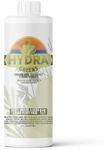Buying Guide for the Best Vegetable Garden Fertilizers
Choosing the right fertilizer for your vegetable garden can make a big difference in the health and productivity of your plants. Fertilizers provide essential nutrients that might be missing from your soil, helping your vegetables grow strong and produce more. The best fertilizer for you depends on your soil’s current condition, the types of vegetables you’re growing, and your gardening goals. Understanding the key specifications of fertilizers will help you make an informed choice that supports your garden’s unique needs.N-P-K RatioThe N-P-K ratio stands for Nitrogen (N), Phosphorus (P), and Potassium (K), which are the three main nutrients plants need. This ratio is usually shown as three numbers on the fertilizer package, like 10-10-10. Nitrogen helps with leafy growth, phosphorus supports root and flower development, and potassium aids overall plant health. If you want lush, green leaves (like for lettuce or spinach), a higher nitrogen number is helpful. For root vegetables or fruiting plants, more phosphorus and potassium are beneficial. To pick the right ratio, consider what you’re growing and what your soil might lack—soil tests can help, or you can choose a balanced fertilizer if you’re unsure.
Fertilizer Type (Organic vs. Synthetic)Fertilizers come in organic and synthetic forms. Organic fertilizers are made from natural materials like compost, manure, or bone meal, and they release nutrients slowly, improving soil health over time. Synthetic fertilizers are manufactured and provide nutrients quickly, which can give plants a fast boost. If you prefer a natural approach and want to build long-term soil health, organic is a good choice. If you need quick results or have specific nutrient deficiencies, synthetic might be more effective. Your gardening philosophy and how quickly you want to see results can guide your choice here.
Release Speed (Slow-Release vs. Quick-Release)Release speed refers to how quickly the nutrients become available to your plants. Slow-release fertilizers break down over time, providing a steady supply of nutrients, which is good for consistent growth and less frequent application. Quick-release fertilizers act fast, which is useful if your plants show signs of nutrient deficiency and need immediate help. If you want low-maintenance gardening, slow-release is convenient. If you’re troubleshooting specific problems or want to boost growth at certain times, quick-release can be helpful.
Form (Granular, Liquid, or Spikes)Fertilizers come in different forms: granular, liquid, and spikes. Granular fertilizers are sprinkled on the soil and are easy to apply for larger areas. Liquid fertilizers are mixed with water and applied directly to the soil or leaves, offering fast absorption and precise feeding. Spikes are solid sticks pushed into the soil, releasing nutrients slowly over time. If you have a big garden, granular is practical. For container plants or targeted feeding, liquid is effective. Spikes are convenient for small gardens or individual plants.
MicronutrientsBesides the main N-P-K nutrients, plants also need small amounts of micronutrients like iron, magnesium, and calcium. Some fertilizers include these extras, which can help prevent deficiencies and support overall plant health. If your soil is already rich in micronutrients, you may not need extra, but if you notice yellowing leaves or poor growth, a fertilizer with added micronutrients can help. Consider your soil’s condition and your plants’ appearance when deciding if you need these.



















